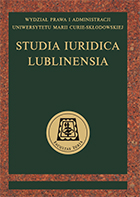Zniesienie pańszczyzny na Spiszu w latach 1931–1934
The Abolition of Corvée in Spisz in the Years 1931–1934
Author(s): Józef CiągwaSubject(s): Law, Constitution, Jurisprudence, Recent History (1900 till today), Geopolitics
Published by: Wydawnictwo Naukowe Uniwersytetu Marii Curie-Sklodowskiej
Keywords: corvée (zsellérség; želiarstvo); abolition of corvée; Spisz (Spiš; Scepusium; Szepesség; Zips); hungarian acts; IX/1848; XI/1848; XXV/1896; act of Polish Parliament of 20 March 1931;
Summary/Abstract: Like the whole of the present-day Slovakia, until the year 1918 the region of Spisz (Spiš, Scepusium, Szepesség, Zips) belonged to the Kingdom of Hungary (Magyar Királyság, Uhorské kráľovstvo, Królestwo Węgierskie). By the power of the decision of the Council of Ambassadors of the 28th of July 1920, a small part of the district of spiska żupa (spišská župa, comitatus scepusiensis, szepes megye, zipser Komitat) – 170 km², amounting to 4.64% of the district’s total area – was incorporated into the territory of the Second Republic of Poland. In the area incorporated into Poland there were 14 villages populated by ca. 9,000 inhabitants. In three of these villages – Falsztyn, Niżne Łapsze and Niedzica – corvée (zsellérség, želiarstvo, żelarstwo) survived until 1934. The perseverance of corvée in the three villages is related to the rulings of two Acts of the Hungarian parliament (No. IX/1848 and No. XI/1848), which abolished feudal liabilities solely with respect to the urbar subjects. These laws, however, did not abolish corvée or other feudal duties in the case of contractual serfs (egyezményi zsellérek, zmluvní želiari, kontraktualisti). The abolition of corvée for this group of serfs, their enfranchisement and granting their property rights only took place on the basis of the Act No. XXV/1896 passed by the Hungarian parliament. This law was in force also in the territory incorporated into Poland in accordance with the letter of the Article 1 of the Act of the 26th of October 1921 concerning the legal regulations in force in the area of the Polish Spisz and Orawa (The Journal of Laws of the Republic of Poland No. 89, pos. 657). However, in meeting their pre-plebiscite promises, the Polish legislator resolved to issue a law abolishing the feudal liabilities in Falsztyn, Niżne Łapsze and Niedzica. The Act of the 20th of March 1931 concerning the abolition of corvée finally abolished all forms of serfdom and other feudal liabilities on the part of the heretofore contractual serfs and granted them enfranchisement. The abolition of corvée and the enfranchisement was effectively carried out in the years 1933–1934 by way of the introduction of a buy-up program. The Act of the Polish parliament determined the price of the buy-up of 1 hectare of the 1st class arable land at 216 Polish zlotys, thus warranting the buyer more advantageous buy-up conditions than those offered by the Hungarian Act No. XXV/1896.
Journal: Studia Iuridica Lublinensia
- Issue Year: 25/2016
- Issue No: 3
- Page Range: 165-178
- Page Count: 14
- Language: Polish

